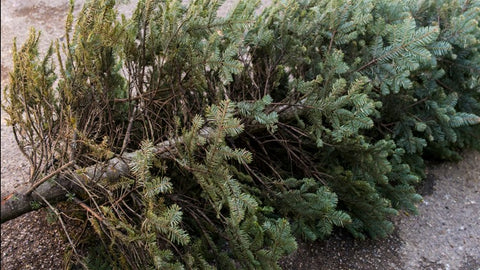Repurpose Your Christmas Tree & Make Wildlife Happy!

You've enjoyed your fresh-cut Christmas tree throughout the season with fresh pine aroma engulfing your home, and needled branches laden with bright lights and treasured ornaments.
Now, the holidays are over and despite weeks of watering, you're starting to find needles on the floor. It's probably time to put the tree out on the curb for the city to haul to the landfill — or maybe grind into mulch for flower gardens at the local park.

But wait, before you get rid of that tree, doesn't it still have some value? Yes! Christmas trees can be repurposed in several ways in your own backyard, so consider using it to help our wild friends. Here are a couple of possibilities:
Make a Christmas tree for songbirds
It's easy: First move the tree to your yard or patio, somewhere you can see it clearly from the house. Then, it's just a matter of decoration. You can use nearly anything:
- Stale breads and bakery products hung by ribbons or string
- Fruits such as apples and oranges (cut in half)
- Cereals of any kind, including Cheerios®, oatmeal, grits or cornmeal (tied in net bags)
- Strings of popcorn or cranberries
- Peanut butter or nuts of any kind mashed into the crevices of pinecones
However you choose to decorate it, your "bird Christmas tree" will provide countless hours of bird-watching fun through the rest of the winter.

Provide shelter from the elements
If you live in a neighborhood where there aren't many trees, you can use your old Christmas tree to provide cover for birds. Simply drive the base of your tree into a snowbank and leave it for the birds to use.
Or, if you have existing trees, merely string some ropes between them and lean the Christmas trees against the ropes.
Build habitat for fish and frogs
Submerged Christmas trees make excellent habitat for fish and other aquatic wildlife. Place cut-up Christmas tree pieces in the bottom of your pond to give fish a place to hide.
Create a fish habitat. If you have a pond or stream on your property, you might want to collect a few more Christmas trees, tie them together and anchor them in the pond or stream with large rocks. This will offer local fish, amphibians and aquatic insects a place to live.

Create new homes for wildlife
You can turn discarded Christmas trees into a brush pile that offers ideal wildlife habitat. These piles provide escape cover, nesting sites and dens for ground squirrels, cottontail rabbits, weasels, skunks, snakes and red foxes.
You can build a brush pile on a larger backyard lot or scatter multiple piles throughout nearby woodlands, meadows or farm areas. Because they attract skunks and snakes, you might not want these piles too close to home!
You can keep your brush pile thriving by adding tree branches that you trim during yard clean-ups later in the year. And if you don't like the somewhat untidy look of your brush pile, simply plant a hedge of roses or raspberries around it!
Use For Your Garden
Whole pine or fir boughs can be used to cover your garden in winter. Think of them as a natural blanket. Or you can trim off most of the branches and use the trunk as a garden post or trellis. You can even cut the trunk into smaller pieces and use as decorative edging.
Use the tree as a trellis in the Spring! Cut off any twiggy growth, getting down to the “bones” of the tree. Prop it in the vegetable garden, where you can plants your cucumbers or pole beans. Train the plants up the tree, and the fruit will hang from the branches like ornaments. Who says you can’t have Christmas in July?
Fun that lasts all year
By thinking ahead, you can extend your enjoyment of that expensive Christmas tree. Use your imagination to create structures and objects beneficial to wildlife. And then keep an eye on the tree — you'll be amazed at the wildlife in your own backyard!
- JoEllen Urasky
